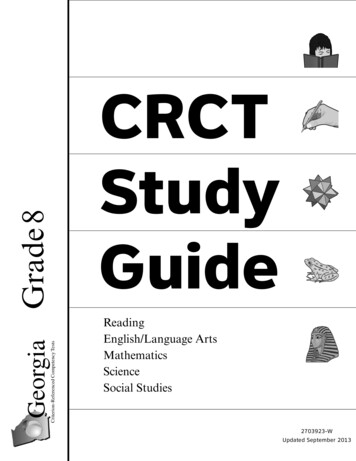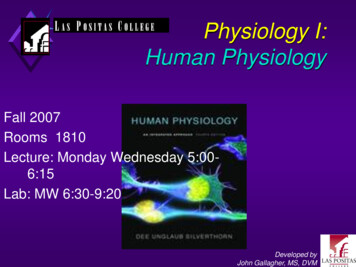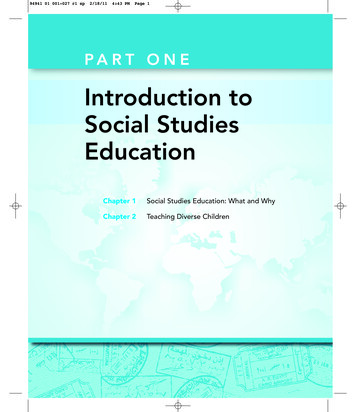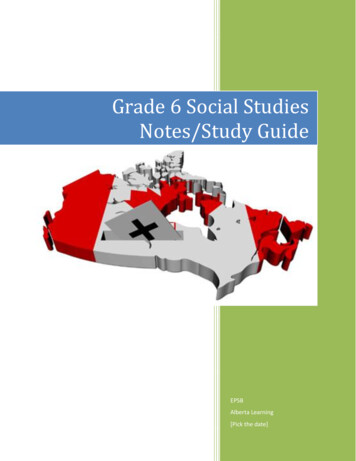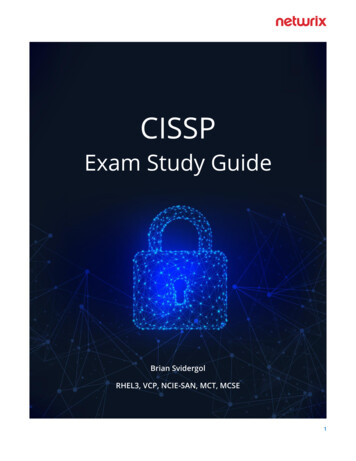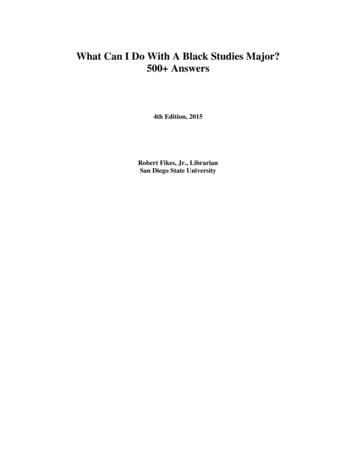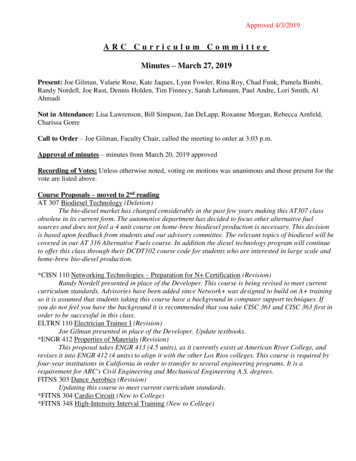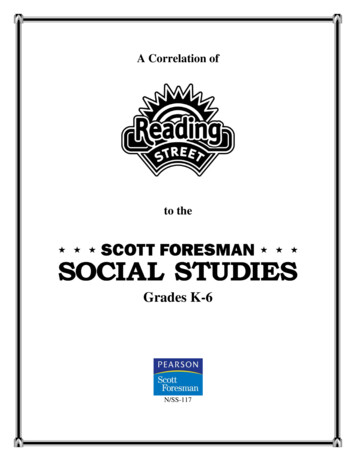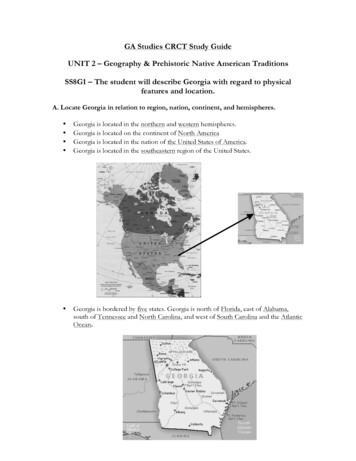
Transcription
GA Studies CRCT Study GuideUNIT 2 – Geography & Prehistoric Native American TraditionsSS8G1 – The student will describe Georgia with regard to physicalfeatures and location.A. Locate Georgia in relation to region, nation, continent, and hemispheres. Georgia is located in the northern and western hemispheres.Georgia is located on the continent of North AmericaGeorgia is located in the nation of the United States of America.Georgia is located in the southeastern region of the United States. Georgia is bordered by five states. Georgia is north of Florida, east of Alabama,south of Tennessee and North Carolina, and west of South Carolina and the AtlanticOcean.
B. Describe the five physiographic regions of Georgia; include the Blue RidgeMountains, Valley and Ridge, Appalachian Plateau, Piedmont, and Coastal Plain. A - The smallest of the five regions C - The site of the first U.S. gold rush D - The most populated region A - GA’s only source of a fossil fuel C - The highest peak, Brasstown Bald D - Contains Georgia’s peaches A - Includes only Dade and Walker County D - The industrial/business heart of Georgia E - The largest physiographic region B - Contains most of the state’s textile industry B - Contains ridges with valleys between D - Contains Atlanta, the state’s largest city C - Highest amount of annual rainfall E - Contains most of Georgia’s peanut & cotton farms D - Contains soil made up of Georgia red clay; means “foot of the mountains”ACBDEC. Locate and evaluate the importance of key physical features on the developmentof Georgia; include the Fall Line, Okefenokee Swamp, Appalachian Mountains,Chattahoochee and Savannah Rivers, and Barrier Islands.Fall kefenokee Swamp2
The dramatic drop in elevation dividing the Coastal Plain from the Piedmont is theFall Line. This feature is believed to represent Georgia’s coastline from millions ofyears ago. The second largest freshwater marsh in the United States is the Okefenokee Swamp. The northern regions of Georgia represent the southern end of the greatAppalachian Mountain Range. Here, the most important industry is tourism. Georgia’s most important river, representing Georgia’s border with Alabama is theChattahoochee River. Georgia’s border with South Carolina is the Savannah River. It was an early sourceof transportation for the colonial settlers. The dramatic drop in elevation caused by the Fall Line causes the rivers to formwaterfalls. Once serving as a protective line against Spanish invaders and pirates, the BarrierIslands now protect Georgia’s mainland from inclement weather.D. Evaluate the impact of climate on Georgia’s development. Conditions on a particular day (i.e., snow, rain, thunderstorms, etc.) are calledweather. Conditions over an extended period of time are called climate. Georgia and its neighbor states are part of a warm region of the United States calledthe Sun Belt. In which of Georgia’s regions would tourists most likely go hiking? Blue Ridge What region attracts people who like to go to the beach? Coastal Plain3
Why does Georgia have a longer growing season than northern states? Georgia islocated within the Sun Why do peanuts and cotton grow well in Georgia? Because of GA’s soil and climate.SS8H1 – The student will evaluate the development of North Americancultures and the impact of European exploration and settlement on theNative American cultures in Georgia.A. Describe the evolution of Native American cultures (Paleo, Archaic, Woodland,and Mississippian) prior to EuropeanTime PeriodTechnologicalAdvancements(i.e., tools,weapons,pottery, etc.)Paleo-Indian10,000 – 8,000B.C.Archaic8,000 –1,000 B.C.Woodland1,000 B.C. –A.D. 1,000Mississippian10001600Clovis pointatlatl;crude potterydecorativepottery; bow &arrowhighly ornatepottery,clothing, jewelryFood Sourceslarge gamelarge game;small game; fish;nuts & berriessmall game;small-scalefarmingsmall game;large-scalefarmingOrganization(i.e., nomadicbands, cities,etc.)small nomadicbandssmall nomadicbandssmall,permanentvillagescities; nations;chiefdomsEvidence ofReligionNANAsmall burialmounds;artisticexpressiongreat mounds;artisticexpression A man-made relic is called an artifact. Examples include: arrowhead; diary; potteryA natural relic is called an ecofact. Examples include: shark’s teeth; bones; fossils4
UNIT 3 – Exploration & ColonizationSS8H1 – The student will evaluate the development of North Americancultures and the impact of European exploration and settlement on theNative American cultures in Georgia.B. Evaluate the impact of European contact on Native American cultures includingSpanish missions along the barrier islands, and the exploration of Hernando de Soto. During the Age of Exploration, European explorers were attempting to find a waterroute to the Indies When Columbus arrived in North America, he believed he was in India. Because ofthis, he called the Native Americans Indians Because Spanish explorers were conquerors, they were called conquistadors. Spain claimed all of the New World and called it La Florida The Spanish explorer, who led an expedition into the American southeast, becomingthe first European to look upon Georgia, was Hernando De Soto. In order to convert the Native Americans to Catholicism, the Spanish establishedmissions along the southeastern coast of North America. Though the Spanish explorers brought weapons and horses to the New World, thething most responsible for the death of thousands of Native Americans was disease.C. Explain reasons for European exploration and settlement of North America, withemphasis on the interests of the French, Spanish, and British in the southeasternarea. The three goals of Spanish exploration in the New World were God, gold, and glory:Ø God refers to the religious motivation to convert the Natives toCatholicism.Ø Gold refers to the economic motivation of discovering new sources ofwealth for the Spanish Empire.Ø Glory refers to the military motivation of conquering new lands for theSpanish Empire.5
The French explorer who established the city of Quebec (in Canada), along with aprosperous fur trade there, was Samuel de Champlain. The French explorer who founded New Orleans was Sieur de La Salle. Under the English king, King Henry VIII, the Catholic Church was replaced withthe Anglican Church (Church of England). In 1588, Spain launched the Spanish Armada in an attempt to conquer England andforce its return to the Catholic Church. The result was disastrous for Spain, and theSpanish Empire never recovered. In 1607, England established its first permanent North American colony atJamestown. By the 1660s, England had established 12 colonies in North America.The final English colony to be founded was Georgia, and it was established by aCharter in the year painPope Alexander nando de Soto1540SpainThree G’s1500sSpainSpanish Missions1500sSpainDescriptionChose to sail westward in his effort to find an allwater route to India; discovered the islands off thecoast of North America; believing he was in India,he described the natives as “Indians”Drew the “Line of Demarcation,” diving the worldbetween the Catholic powers of Spain and Portugal;Portugal was guaranteed their routes around Africa;Spain was guaranteed all western routes to theIndies (and all newly discovered lands in between)Spanish explorers almost always explored asofficers of the Spanish Imperial Army; theirexplorations, therefore, were “conquests”Spanish conquistador who became the firstEuropean to explore the interior of what wouldbecome the southeastern United States; he was thefirst European to enter Georgia and the first tolook upon the Mississippi River.The motivations of Spanish exploration (God –religious motivation; Gold – economic motivation;Glory – military motivation)Established in the coast of La Florida to convertNative Americans to Roman Catholicism (by forceif necessary)6
NameApprox.DateNationDescriptionExplored the Mississippi basin, naming it LaLouisiane, and claimed it in the name of France.Sieur de La Salle1682FranceKing Henry VIII1530sEnglandSpanish l de Champlain1608FranceKing of England who used his authority to removeEngland from the Catholic Church and establishthe Anglican Church (Church of England)Failed attempt by Spain to launch a massive fleet toinvade England and force it back into the CatholicChurch; Spain never recovered from the disaster.The first permanent English colony in NorthAmerica, representing the decline of Spanish powerand the rise of English power.Father of “New France” who founded New Franceand the city of Quebec, and established the furtrade there.BA. SPAINB. FRANCECC. ENGLANDAB7
SS8H2 – The student will analyze the colonial period of Georgia’shistory.A. Explain the importance of James Oglethorpe, the Charter of 1732, reasons forsettlement (charity, economics, and defense), Tomochichi, Mary Musgrove, and thecity of Savannah. The father of the colony of Georgia was Sir James Oglethorpe, who wasoverwhelmed by the terrible conditions of England’s prisons, and felt that manypoor unfortunates had been wrongly imprisoned. He wanted to found a new colonywhere these poor unfortunates, debtors, etc., could get a fresh start away from thecorruption of English society. King George II granted permission to found a new colony in the year 1732. According the charter for the new colony, the colony would have three purposes(C, E, D):Ø Charity - the colony would be a place for the poor unfortunate to get a new startØ Economics - the colony would be a source of wealth for EnglandØ Defense - the colony would serve as a “buffer colony” to protect SouthCarolina from the Spanish threat in La Florida. Under the terms of the charter, certain things were not permitted:Ø Land ownershipØ Alcoholic beveragesØ SlaveryØ Lawyers Under the terms of the charter, the colony would be governed by James Oglethorpeand twenty other men, who held the colony in trust for the King. These men,therefore, were called Trustees. The original name for the settlement of Savannah was Yamacraw Bluff, named afterthe local Native American tribe. The chief of the local Yamacraw Indians was Tomochichi. Oglethorpe’s female interpreter and assistant was Mary Musgrove.8
According to the Charter of 1732, how were Georgia’s borders defined: Georgiaextended from the mouth of the Altamaha and St. Mary’s Rivers on the Atlanticcoast to the Pacific coast.B. Evaluate the Trustee Period of Georgia’s colonial history emphasizing the role ofthe Salzburgers, Highland Scots, malcontents, and the Spanish threat from Florida. One of the few groups of people to prosper economically during the Trustee periodwas the Salzburgers, a group of German Protestants from Austria who settled in thetown of Ebenezer. One particular ethnic group, the Highland Scots, was recruited in order to helpdefend Georgia against the Spanish threat from La Florida. They settled in the townof Darien. One group of colonists, the malcontents, were a major frustration for the Trusteesbecause of their constant complaining about the colony’s rules and restrictions. Oglethorpe finally ended the Spanish threat from Florida after defeating a Spanishinvasion at the Battle of Bloody Marsh. This battle was important because itpermanently ended the Spanish threat to Georgia.C. Explain the development of Georgia as a royal colony with regard to landownership, slavery, government, and the impact of the royal governors. Georgia’s first royal governor who was too stern and often had conflicts with thecolonists was Captain John Reynolds. Georgia’s second royal governor, who was popular but too old and sickly, was SirHenry Ellis. Georgia’s third and most successful royal governor was Sir James Wright. In orderto recruit more settlers to Georgia, he established a system of land distribution,whereby heads of household would receive large amounts of land, in addition to landgrants for each family member. This system was called the headright system. Georgia’s legislature, established during the Royal Period, was called the House ofAssembly. During the Royal Period, therefore, Georgians gained limited selfgovernment. How did Georgia’s restrictions on slavery and land ownership change during theRoyal Period? At the end of the Trustee Period, Georgia residents were permitted toown land and slaves; the first slaves were brought to Georgia in 1752.9
UNIT 4 – StatehoodSS8H3 – The student will analyze the role of Georgia in the AmericanRevolution.A. Explain the immediate and long-term causes of the American Revolution andtheir impact on Georgia, including the Seven Years’ War, Proclamation of 1763,Stamp Act, Intolerable Acts, and the Declaration of Independence. DThough England was victorious over France,she was left with a massive debt and looked toAmerican colonies to help pay it.A. Proclamation of 1763B. Declaration of Independence AFEIn order to keep the colonists from conflictwith Native Americans, and in order to make iteasier to tax the colonies, King George III issuedthis law forbidding colonists from settling westof the Appalachian Mountains.One of the measures adopted by England to taxthe colonies, requiring a stamp to be purchaseda placed on every paper good; this was the firstincident of widespread opposition to England.In response to continuous colonial rebellion,including the Boston Tea Party, England passedthis series of harsh laws designed to punish thecolony of Massachusetts and set an example forthe other colonies. This caused the othercolonies to discuss the possibility of unitingagainst English oppression.C. Lexington & ConcordD. Seven Years’ War (or,French & Indian War)E. Intolerable ActsF. Stamp Act CThe first battle of the Revolutionary War; foughtin 1775, it was known as the “shot heard ‘roundthe world” because it changed the course ofworld history. BIn Philadelphia, on July 4, 1776, representativesfrom all thirteen colonies signed this document,explaining the reasons why the colonies shouldbe free of English rule. It was written primarilyby Thomas Jefferson. As a result of the Seven Year’s War, Georgia’s western border was changed from thePacific Ocean to the Mississippi River.10
B. Analyze the significance of people and events in Georgia on the RevolutionaryWar to include Loyalists, Patriots, Elijah Clarke, Austin Dabney, Nancy Hart, ButtonGwinnett, Lyman Hall, the Battle of Kettle Creek, and the Siege of Savannah. The three Georgia delegates who signed the Declaration of Independence were ButtonGwinnett, Lyman Hall, and George Walton. Those who supported American Independence were called Whigs/Patriots, and theylived primarily in the backcountry/upcountry. Those who were loyal to the King ofEngland were called Tories/Whigs, and they lived primarily around the port city ofSavannah. Most people in Georgia were Tories/Whigs. In the most important Revolutionary War battle fought in Georgia, the Whigsdefeated the British at Kettle Creek, preventing the British from capturing thebackcountry. The Whig commander, famous for the use of guerilla tactics, wasElijah Clarke. A slave by the name of Austin Dabney fought for the Whigs here andserved as an American spy. The Americans were defeated in their attempt to capture the city of Savannah fromthe British. This was the second bloodiest battle of the Revolutionary War. The six-foot tall, red-headed “Wauhatchie War Woman,” named Nancy Hart, servedas a Whig spy and, according to legend, killed several British troops who trespassedon her property.SS8H4 – The student will describe the impact of events that led to theratification of the United States Constitution and the Bill of Rights.A. Analyze the strengths and weaknesses of both the Georgia Constitution of 1777and the Articles of Confederation and explain how the Articles of Confederation ledto a need to revise the Articles. The first national form of government was called the Articles of Confederation.The first permanent state government was called the Constitution of 1777. Both governments reflected American fears of another strong central governmentlike the one experienced under British rule. In order to prevent this, bothgovernments purposely made the executive branch extremely weak and the legislativebranch too powerful. As a result, both governments were eventually replaced.11
Basic Functions of GovernmentLegislativeLawExplainingLaw MakingJudicialLawEnforcingExecutiveThe Articles of ConfederationDescription of the Legislative BranchUnder the A.O.C.Unicameral Congress; no power to levytaxes; was unable to pass any legislationwithout the approval of all statesDescription of the Executive BranchUnder the A.O.C.No executive branch under the Articles ofConfederationDescription of the Judicial BranchUnder the A.O.C.No judicial branch under the Articles ofConfederationStrengths of the A.O.C.Established the principle of representativegovernment; had a written constitutionWeaknesses of the A.O.C.No real power to tax; no ability to enforce orinterpret legislation; no ability to raise anarmy for the common defense.12
The Georgia Constitution of 1777Unicameral body called the GeneralAssembly; most powerful of all branches,with significant power of the executive andjudicial branchGovernor elected by the General Assemblyand limited to a one-year term; 12-manexecutive council appointed by the GeneralAssemblyDescription of the Legislative BranchUnder the Constitution of 1777Description of the Executive BranchUnder the Constitution of 1777Description of the Judicial BranchUnder the Constitution of 1777.A Superior Court was created for each ofGeorgia’s countiesAttempted to create a separation of powersand a representative government; a writtenconstitution outlining basic rightsThe legislative branch was given too muchpower, while the executive branch was toolimited; because most Georgians wereTories, the Constitution of 1777 (a Whigdocument), was never ratifiedStrengths of the Constitution of 1777Weaknesses of the Constitution of 1777B. Describe the role of Georgia at the Constitutional Convention of 1787 includingthe role of Abraham Baldwin and William Few, and reasons why Georgia ratified thenew constitution. Because of the weaknesses of the Articles of Confederation, representatives from thestates met in Philadelphia in 1787 for the purpose of “revising” the Articles. Ultimately,the Articles were replaced by the United States Constitution. This gathering of delegates,therefore, was called the Constitutional Convention. Georgia appointed six delegates to go to Philadelphia, but only two signed theConstitution. They were Abraham Baldwin and William Few. The greatest debate in Philadelphia concerned the issue of representation. States withlarger populations (e.g., New York, Pennsylvania, etc.) wanted the representation ofstates to be based on population. States with smaller populations (e.g., Delaware,Georgia, etc.) wanted states to be represented equally. The debate was resolved with thecreation of a bicameral legislature made up of two houses, the House of Representativesand the Senate. This solution was called the Great Compromise. Georgia supported ratifying (approving) the Constitution because of the hope that astrong government would provide protection against Indians and the Spanish threatfrom Florida. Georgia became the 4th state to ratify the U.S. Constitution.13
The U.S. Government under the ConstitutionAA. The U.S. Congress(House of Representatives& Senate)B. The U.S. Supreme CourtC. The U.S. President andVice PresidentCBGeorgia’s Government under the Constitution of 1983AA. The General Assembly(House of Representatives& State Senate)B. The GA Supreme CourtC. The Governor andLieutenant GovernorCB14
SS8H5 – The student will explain the significant factors that affected thedevelopment of Georgia as part of the growth of the United Satesbetween 1789 and 1840.A. Explain the establishment of the University of Georgia, Louisville, and the spreadof Baptist and Methodist churches. The first public, land-grant institution of higher learning in American history was theUniversity of Georgia. The charter for this university was written by AbrahamBaldwin, who had signed the U.S. Constitution on behalf of Georgia. Throughout Georgia’s history, there have been five state capitals. These capitalsmoved further and further west, following Georgia’s population. Georgia’s fivecapital cities are:Ø SavannahØ AugustaØ LouisvilleØ MilledgevilleØ Atlanta The Georgia Governor most responsible for the rebuilding of churches after theRevolutionary War was Lyman Hall, who had also signed the Declaration ofIndependence on Georgia’s behalf. To the present day, Georgia’s largest Christiandenominations are Baptist and Methodist.B. Evaluate the impact of land policies pursued by Georgia to include the headrightsystem, land lotteries, and the Yazoo land fraud. In order to attract more people to settle in Georgia, Georgia’s leaders continuedpolicies of land distribution. Unfortunately, the land policies were abused by corruptlegislators and land speculators. This scandal was called the Yazoo Land Fraud. After the scandal, Georgia’s headright system was replaced with the land lotteries inwhich individuals who lived in Georgia were given a chance to win land in a drawing.Those who won land this way were called fortunate drawers. Georgia’s western lands were given to the U.S. government, and eventually the statesof Alabama and Mississippi were created by the government.15
C. Explain how technological developments including the cotton gin and railroadsimpacted Georgia growth. In 1793, Eli Whitney invented the cotton gin, a device which extracted seeds fromcotton, making the growing of cotton extremely cost efficient. Soon Georgia wasthe largest cotton producer in the world, and cotton became known as “KingCotton”. In order to support the growing cotton industry, the south became moredependent on slavery. To transport cotton to the port city of Savannah, Georgia needed a new system oftransportation faster and more reliable than the rivers and wagon trails. Georgiaturned to railroads as the major system of transportation. On of Georgia’s most important railroads was the Western & Atlantic railroad,connecting Ross’s Landing (later Chattanooga) in the north to central Georgia. Thesouthern termination point of the W&A Railroad was called Terminus. In a matterof years, the southern end of the railroad grew into a small town that was renamedMarthasville after the daughter of railroad supporter, Gov. Lumpkin. By 1845, thetown had grown into a bustling city and was renamed Atlanta, after the Western &Atlantic Railroad.D. Analyze the events that led to the removal of Creeks and Cherokees including theroles of Alexander McGillivray, William McIntosh, Sequoyah, John Ross, DahlonegaGold Rush, Worcester v. Georgia, Andrew Jackson, John Marshall, and the Trail ofTears. The two great Indian nations in Georgia were the Creek, residing in south Georgia,and the Cherokee, residing in north Georgia. Georgians came to distrust the Creek because the Creek had sided with Great Britainduring the Revolutionary War. Some Creeks, like the great Creek warrior AlexanderMcGillivray had brutally attacked Whig settlements on the frontier during the war.As the U.S. continued to grow, the Creek were forced to give up more and more oftheir land. Ultimately, with the Treaty of Indian Springs of 1825, all Creek lands inGeorgia were surrendered by Creek Chief William McIntosh, who was afterwardsassassinated by a Creek war party. The discovery of gold in Dahlonega in 1828 brought whites into contact with theCherokee. Though the Cherokee were extremely advanced and “civilized” (evenpossessing a writing system invented by Sequoyah), whites wanted the Cherokees tobecome GA citizens or to leave. In 1830, the Indian Removal Act was signed byPresident Andrew Jackson, forcing Indians to move west of the Mississippi. The Cherokee, led by John Ross, sued the U.S. government in court. In the famousU.S. Supreme Court decision, called Worcester v Georgia, the Chief Justice of the U.S.John Marshall ruled the Indian Removal Act unconstitutional.16
The Supreme Court’s decision was ignored, and in 1838, 14000 Cherokee wereforced out of the southeastern United States on an 800-mile journey to the Indianterritory known as the Trail of Tears.UNIT 5 – Sectionalism,Civil War & ReconstructionA. Explain the importance of key issues and events that led to the Civil Warincluding slavery, states’ rights, nullification, Missouri Compromise, Compromise of1850 and the Georgia Platform, Kansas-Nebraska Act, Dred Scott case, election of1860, the debate over secession in Georgia, and the role of Alexander Stephens. During the 1800s, the northern states had an economy based on industry while thesouth had an economy based on agriculture. As the south’s dependence onagricultural products, primarily “King Cotton” grew, so did the south’s dependenceupon slavery as a source of labor. Northerners came to oppose slavery because they could not compete with thesouth’s source of free labor and many came to believe it was morally evil. Thosewho argued for an immediate end to slavery were called abolitionists. Many in the north came to believe in nationalism, the idea that the interests of theentire nation are more important that those of a particular state or region.Southerners, on the other hand, held to states’ rights or sectionalism, the idea thatthe interests of the states were more important than those of the nation. A protective tariff is a tax on an imported good Explain the south’s position on protective tariffs and why it felt that way:Southerners opposed protective tariffs because they benefitted northern business atthe expense of southern farming. After the “nullification crisis” of 1828, President Jackson grew extremelyunpopular in the South because of his decision to side with nationalists over againstsouthern sectionalists. In Georgia, however, Jackson remained popular because ofJackson’s role in Indian removal.17
From the 1820s to the 1860s, several compromises and events drew the North andSouth closer and closer to conflict:Compromise/EventMissouri CompromiseNullification CrisisDateDescription1820Missouri is admitted to the Union as a slavestate; Maine is admitted to the Union as afree state (therefore maintaining balance inthe Senate); the 36 30 line became theboundary for future slave and free statesWhy Does this CauseConflict?The regionaldifferences betweenNorth and Southbecome a legal realitywith the 36 30 line1832South Carolina passed an Ordinance ofNullification, declaring the federal tariff of1832 “null and void”; S.C. repealed theordinance after President Andrew Jacksonthreatened to invade.Southerners becamewary of the federalgovernment’swillingness to use forceagainst the SouthControversy grew over the issue of slaveryin territories won from Mexico in 1848;under this Compromise, California wasadmitted as a free state, the slave trade wasabolished in Washington, D.C., and a strictfugitive slave act was enacted“States’ rights” forNorthern states wasviolated by beingforced to submit to thefugitive slave actCompromise of 18501850Georgia Platform tothe Compromise of18501850Kansas-Nebraska Act1854Dred Scott Decision1857Election of 18601860Georgia threatens to secede from theUnion if northern statements fail toadequately enforce the fugitive slave act.The threat of secessionis once again used toforce northerntolerance of southernslaveryIn order to influencePeople living in Kansas and Nebraska werethe vote on slaverypermitted to determine the status of slaverywithin Kansas, prowithin their states for themselves (i.e., theand anti- slavery forcesdoctrine of popular sovereignty)resorted to fighting(“Bleeding Kansas”)Dred Scott, a slave who was taken, by hisNorthern states weremaster, to live in a free state sued for hisessentially declared tofreedom; the Supreme Court ruled that onlybe slave states; thecitizens could sue in court, and thatnorth was no longerCongress could not regulate privatewilling to compromiseproperty without due processwith the southRepublican Abraham Lincoln defeats JohnConvinced thatC. Breckinridge (Southern Democrat),Lincoln’s PresidencyStephen A. Douglas (Northern Democrat),meant the end ofand John Bell (Constitutional Union) toslavery, the seven statesbecome 16th U.S. President on a platform ofof the Deep Southpreventing the spread of slavery.responded by seceding.18
After the election of Abraham Lincoln in 1860, the seven states of the deep southchose to secede, or leave the Union. These states were: South Carolina, Mississippi,Florida, Alabama, Georgia, Louisiana, and Texas. After fighting began at Ft. Sumter in April 1861, four states of the upper south choseto secede from the Union. These states were: Virginia, Arkansas, North Carolina,and Tennessee. There were four slave states that chose to remain in the Union. They were calledborder states. These states were (note: in 1861, West Virginia did not yet exist):Missouri, Kentucky, Maryland, and Delaware. Georgia was divided on the question of secession but ultimately became one of thefirst seven states to leave the Union.OriginallyWho am I?againstsecessionUnited StatesSenator fromAlexander H. StephensGeorgia BecameVice Presidentof the C.S.A.19
B. State the importance of key events of the Civil War to include Antietam,Emancipation Proclamation, Gettysburg, Chickamauga, the Union blockade ofGeorgia’s coast, Sherman’s Atlanta Campaign, Sherman’s March to the Sea, andAndersonville. The Civil War lasted from 1861 to 1865 and was fought between the United Statesof America (the North) and the Confederate States of America (the South). Originally, President Lincoln’s war aim/goal was not
The northern regions of Georgia represent the southern end of the great Appalachian Mountain Range. Here, the most important industry is tourism. Georgia’s most important river, representing Georgia’s border with Alabama is the Chattahoochee River. Georgia’s border with Sou
